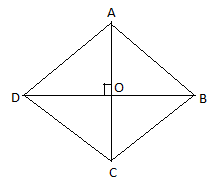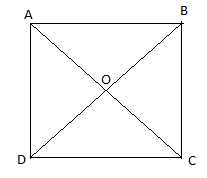
Prove that the rhombus with equal diagonals is a square.
Answer
602.7k+ views
Hint:Draw a figure of rhombus when diagonals are equal. In rhombus, the diagonals bisect each other at right angles. Prove that the vertices are also right angles.
Complete step by step answer:
From the figure, let us say that ABCD is a rhombus.


Let AC and BD be the diagonals of the rhombus. It is said that the rhombus has equal diagonals, i.e. AC = BD.
We know that diagonals of rhombus bisect each other. Thus we can say that AC = BD.
If AC = BD, then
AO = BO = CO = DO…..(1)
Consider the point where the diagonals intersect at O.
Let us consider the \[\Delta AOB\].
From equation (1) we can say that AO = BO and \[\angle AOB={{90}^{\circ }}\].
In rhombus, the diagonals bisect each other at right angles. Each diagonal cuts the other into two equal parts and the angle where they cross is always a right angle.
\[\therefore \angle AOB={{90}^{\circ }}\].
Thus we can say that \[\angle OAB=\angle OBA=\dfrac{{{90}^{\circ }}}{2}={{45}^{\circ }}\]
Similarly in \[\Delta AOD\], \[\angle OAD=\angle ODA=\dfrac{{{90}^{\circ }}}{2}={{45}^{\circ }}\]
Thus from the figure,
\[\angle A=\angle OAB+\angle OAD={{45}^{\circ }}+{{45}^{\circ }}={{90}^{\circ }}\]
Similarly, from the figure,
\[\angle B=\angle C=\angle D={{90}^{\circ }}\]
\[\therefore \]All the angles, \[\angle A=\angle B=\angle C=\angle D={{90}^{\circ }}\]
All the sides are also equal, i.e. AB = BC = CD = DA.
\[\therefore \]Quadrilateral ABCD is a square.
Therefore, we proved that a rhombus with equal diagonals is a square.
Note:In case of a square, we know the general properties, that all sides of a square are equal in length. Thus the diagonals of a square are equal in length and diagonals bisect each other. The angles are \[{{90}^{\circ }}\]. Thus the square has 4 congruent sides and 4 right angles.
Complete step by step answer:
From the figure, let us say that ABCD is a rhombus.


Let AC and BD be the diagonals of the rhombus. It is said that the rhombus has equal diagonals, i.e. AC = BD.
We know that diagonals of rhombus bisect each other. Thus we can say that AC = BD.
If AC = BD, then
AO = BO = CO = DO…..(1)
Consider the point where the diagonals intersect at O.
Let us consider the \[\Delta AOB\].
From equation (1) we can say that AO = BO and \[\angle AOB={{90}^{\circ }}\].
In rhombus, the diagonals bisect each other at right angles. Each diagonal cuts the other into two equal parts and the angle where they cross is always a right angle.
\[\therefore \angle AOB={{90}^{\circ }}\].
Thus we can say that \[\angle OAB=\angle OBA=\dfrac{{{90}^{\circ }}}{2}={{45}^{\circ }}\]
Similarly in \[\Delta AOD\], \[\angle OAD=\angle ODA=\dfrac{{{90}^{\circ }}}{2}={{45}^{\circ }}\]
Thus from the figure,
\[\angle A=\angle OAB+\angle OAD={{45}^{\circ }}+{{45}^{\circ }}={{90}^{\circ }}\]
Similarly, from the figure,
\[\angle B=\angle C=\angle D={{90}^{\circ }}\]
\[\therefore \]All the angles, \[\angle A=\angle B=\angle C=\angle D={{90}^{\circ }}\]
All the sides are also equal, i.e. AB = BC = CD = DA.
\[\therefore \]Quadrilateral ABCD is a square.
Therefore, we proved that a rhombus with equal diagonals is a square.
Note:In case of a square, we know the general properties, that all sides of a square are equal in length. Thus the diagonals of a square are equal in length and diagonals bisect each other. The angles are \[{{90}^{\circ }}\]. Thus the square has 4 congruent sides and 4 right angles.
Recently Updated Pages
Master Class 9 Social Science: Engaging Questions & Answers for Success

Master Class 9 Science: Engaging Questions & Answers for Success

Master Class 9 English: Engaging Questions & Answers for Success

Master Class 9 Maths: Engaging Questions & Answers for Success

Master Class 9 General Knowledge: Engaging Questions & Answers for Success

Class 9 Question and Answer - Your Ultimate Solutions Guide

Trending doubts
Which places in India experience sunrise first and class 9 social science CBSE

Fill the blanks with the suitable prepositions 1 The class 9 english CBSE

Write the 6 fundamental rights of India and explain in detail

Difference Between Plant Cell and Animal Cell

What is pollution? How many types of pollution? Define it

What is the Full Form of ISI and RAW




